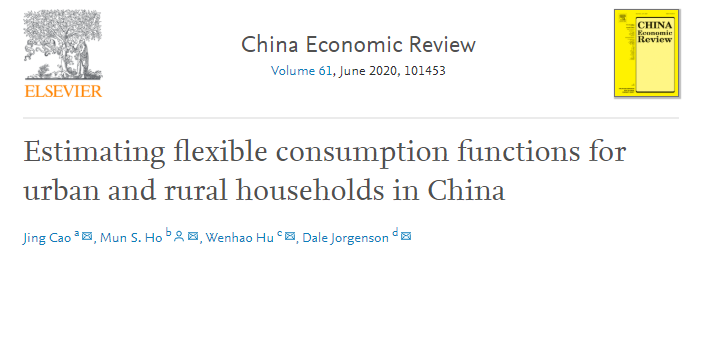时间:2020-06-29

Estimating flexible consumption functions for urban and rural households in China
China Economic Review, Vol. 61, June 2020, 101453
Jing Cao, Mun S. Ho, Wenhao Hu (胡文皓), Dale Jorgenson
Abstract
There are few comprehensive studies of household consumption in China that covers all commodities due to data restrictions. This prevents the calculation of inequality indices based on consumption. This lack of coverage also makes analysis of policies that affect consumption difficult; economy-wide models used for analysis often have to employ simple consumption forms with unit income elasticities. We estimate a translog demand system distinguished by demographic characteristics, giving price and income elasticities that should be useful for policy analysis. We estimate separate functions for urban and rural households using household expenditure data and detailed commodity prices (1995–2006). This allows future analysis of social welfare and inequality based on consumption to supplement existing studies based on income. To illustrate an application of the model, we project consumption composition based on projected prices, incomes and demographic changes – aging, education improvement and urbanization.
摘要:本文使用一个双重对数模型对我国城乡家庭的消费行为进行了分析。在该模型中,我们详细区分了家庭的各类特征,从而能够有效地比较不同类型家庭在消费行为上的差异。为了更准确地对模型进行估计,本文使用了详细的家庭各类消费数据以及各地不同商品的价格数据。本文的估计结果,不仅能够为相关的政策研究提供相应的参数,也能够为后续的基于消费的福利分析创造有利的条件。为了进一步说明模型估计在应用中的有效性,本文对我国城乡家庭的消费结构进行了模拟,模拟结果与现实结果呈现出比较好的一致性。
研究意义:由于数据方面的原因,现有研究还很少从全部类商品系统角度来研究我国家庭的消费行为。这不仅使得基于消费的福利分析无法进行,也使得很多相关的政策性分析研究无法有效地开展。例如,在很多一般均衡模型的政策研究中,由于缺乏相关的估计参数,研究者往往只能够简单地假设各类消费的收入弹性为1。而本文的估计结果,则可以为这些政策性研究,提供了可供参考的参数,有助于提高其模拟的准确性。另一方面,现有关于不平等和福利的研究往往基于收入进行分析,本文的研究结果,为进一步进行基于消费的不平等和福利分析创造了条件。
文章全文参见链接:
https://www.sciencedirect.com/science/article/abs/pii/S1043951X2030050X